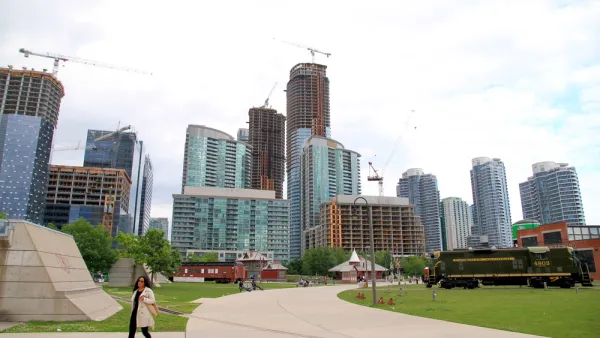The question of how and where to grow is causing controversy in Toronto. A recent op-ed picks a side.

An op-ed by Dave Wilkes, president and CEO of the Building Industry and Land Development Association (BILD), announces support for proposed changes to the controversial Growth Plan under consideration in Toronto.
For Wilkes, the question of whether to support the plan comes down to housing, and the current plan isn't building enough of it.
Much has been written about the proposed changes to the Growth Plan, the policy that manages growth in the Greater Golden Horseshoe. Many commentators have warned that the changes will bring more sprawl. By using that loaded word, they obscure the real issue we should be discussing: How do we build an adequate supply of housing for people in our region in a sustainable way?
Right now, we are not building nearly enough to accommodate the 115,000 people arriving in the GTA every year, and our worsening housing affordability attests to that. With the proposed changes to the Growth Plan, the provincial government is taking action to help increase housing supply while continuing to protect the environment.
According to Wilkes, the areas of the region targeted for growth are too resistant to new development for the plan to be effective. So density isn't being added to the areas with the transportation infrastructure to support it.
Instead, densification is being pushed to outlying areas of municipalities like Brampton, Vaughan and Pickering, on land designated for future development. Often, these areas are not served by transit, so residents have to drive, contributing to the traffic congestion and emissions that the Growth Plan was meant to alleviate.
Wilkes is responding to the position described in a news article by Ben Spurr from January of this year. Ontario Premier Doug Ford ran for office on a campaign platform that included a plan to expand the growth boundary surrounding the region.
FULL STORY: BILD: A lack of housing is the real issue

National Parks Layoffs Will Cause Communities to Lose Billions
Thousands of essential park workers were laid off this week, just before the busy spring break season.

Retro-silient?: America’s First “Eco-burb,” The Woodlands Turns 50
A master-planned community north of Houston offers lessons on green infrastructure and resilient design, but falls short of its founder’s lofty affordability and walkability goals.

Delivering for America Plan Will Downgrade Mail Service in at Least 49.5 Percent of Zip Codes
Republican and Democrat lawmakers criticize the plan for its disproportionate negative impact on rural communities.

Test News Post 1
This is a summary

Test News Headline 46
Test for the image on the front page.

Balancing Bombs and Butterflies: How the National Guard Protects a Rare Species
The National Guard at Fort Indiantown Gap uses GIS technology and land management strategies to balance military training with conservation efforts, ensuring the survival of the rare eastern regal fritillary butterfly.
Urban Design for Planners 1: Software Tools
This six-course series explores essential urban design concepts using open source software and equips planners with the tools they need to participate fully in the urban design process.
Planning for Universal Design
Learn the tools for implementing Universal Design in planning regulations.
EMC Planning Group, Inc.
Planetizen
Planetizen
Mpact (formerly Rail~Volution)
Great Falls Development Authority, Inc.
HUDs Office of Policy Development and Research
NYU Wagner Graduate School of Public Service





























